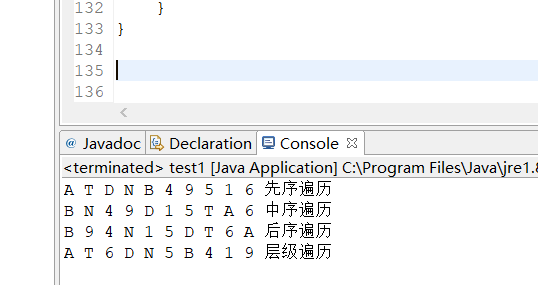| 这个作业属于哪个课程 | 2018级软件工程4班 |
|---|---|
| 这个作业要求在哪里 | 第八周作业 |
| 这个作业的目标 | 1.用排序算法找数组中第K大的数 2.用搜索算法实现二叉树的先、中、后序遍历与层级遍历,将结果打印到控制台 |
| 其他参考文献 | CSDN二叉树的遍历算法 |
第一题
1.题目名称:用排序算法找数组中第K大的数
2.解题思路:定义一个原始数组并初始化,写一个循环,用来处理多组数据。再定义一个临时数组,然后根据Arrays对象的sort方法将l到r的数据升序存入。
3.解题代码:
package test;
import java.util.Arrays;
import java.util.Scanner;
public class Main {
public static void main(String[] args) {
Scanner scan = new Scanner(System.in);
//定义一个原始数组并初始化
//输入序列的长度
int n = scan.nextInt();
int[] a = new int[n];
//输入序列内的数字
for (int i = 0; i < a.length; i++) {
a[i] = scan.nextInt();
}
//输入询问的个数
int nn = scan.nextInt();
int[] b = new int[nn];
int l = 0;
int r = 0;
int k = 0;
//分别输入每行的l、r、k
for (int i = 0; i < nn; i++) {
l = scan.nextInt();
r = scan.nextInt();
k = scan.nextInt();
int nnn = r-l+1;
int[] c = new int[nnn];
for (int j = l,w = 0; j <= r; j++,w++) {
c[w] = a[j-1];
}
//根据sort方法进行升序传入
Arrays.sort(c);
b[i] = c[nnn-k];
}
//输出结果
for (int i = 0; i < b.length; i++) {
System.out.println(b[i]);
}
}
}
执行结果:

第二题
1.题目名称:二叉树的先、中、后 序遍历与层级遍历
2.解题思路:参考CSDN的二叉树的先、中、后 序遍历与层级遍历的解答
先序:到一个节点后,即刻输出该节点的值,并继续遍历其左右子树。(根左右)
中序:到一个节点后,将其暂存,遍历完左子树后,再输出该节点的值,然后遍历右子树。(左根右)
后序:到一个节点后,将其暂存,遍历完左右子树后,再输出该节点的值。(左右根)
3.解题代码:
package test;
import java.util.LinkedList;
public class test1 {
public static void main(String[] args) {
/* 二叉树的结构
A
/
T 6
/
D
/
N 5
/ /
B 4 1
9
*/
Node root = into();
// 先序遍历
A(root);
System.out.println("先序遍历");
// 中序遍历
B(root);
System.out.println("中序遍历");
// 后续遍历
C(root);
System.out.println("后序遍历");
// 层级遍历
D(root);
System.out.println("层级遍历");
}
private static void A(Node tree) {
// TODO 先序遍历
if (tree != null) {
System.out.print(tree.data + " ");
A(tree.l);
A(tree.r);
}
}
private static void B(Node tree) {
// TODO 中序遍历
if (tree != null) {
B(tree.l);
System.out.print(tree.data + " ");
B(tree.r);
}
}
private static void C(Node tree) {
// TODO 后续遍历
if (tree != null) {
C(tree.l);
C(tree.r);
System.out.print(tree.data + " ");
}
}
private static void D(Node tree) {
// TODO 层级遍历
if (tree != null) {
LinkedList<Node> linkedList = new LinkedList<Node>();
//先将根节点入队,LinkedList类是双向列表,列表中的每个节点都包含了对前一个和后一个元素的引用.
linkedList.offer(tree);
Node node = null;
while (!linkedList.isEmpty()) {
node = (Node) linkedList.pop();
System.out.print(node.data + " ");
if (node.l != null) {
//将出队结点的左子树根入队
linkedList.offer(node.l);
}
if (node.r != null) {
//将出队结点的右子树根入队
linkedList.offer(node.r);
}
}
}
}
// 构建一颗树,返回根节点
private static Node into(){
Node root = new Node("A");
Node node1 = new Node("T");
Node node2 = new Node("D");
Node node3 = new Node("N");
Node node4 = new Node("B");
Node node5 = new Node("6");
Node node6 = new Node("5");
Node node7 = new Node("4");
Node node8 = new Node("9");
Node node9 = new Node("1");
root.l = node1;
node1.l = node2;
node2.l = node3;
node2.r = node6;
node3.r = node7;
node7.r = node8;
node6.l = node9;
node3.l = node4;
root.r = node5;
return root;
}
// 节点
static class Node{
// 数据
Object data;
// 左孩子
Node l;
// 右孩子
Node r;
public Node(){}
public Node(Object data) {
this.data = data;
this.l = null;
this.r = null;
}
public Node(Object data, Node l, Node r) {
this.data = data;
this.l = l;
this.r = r;
}
}
}
